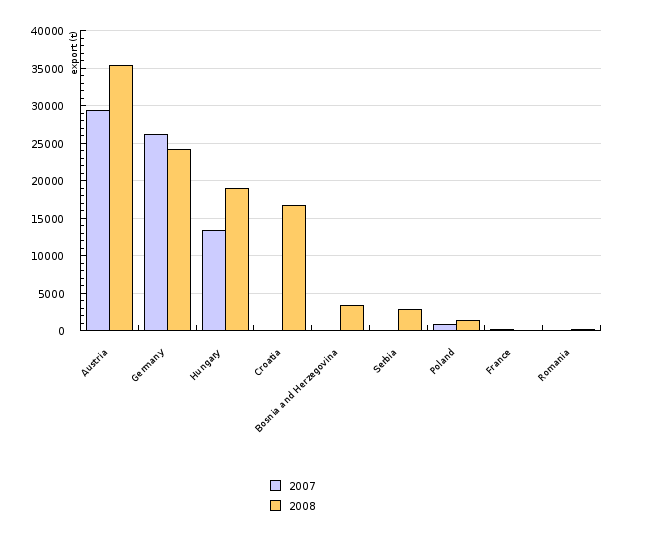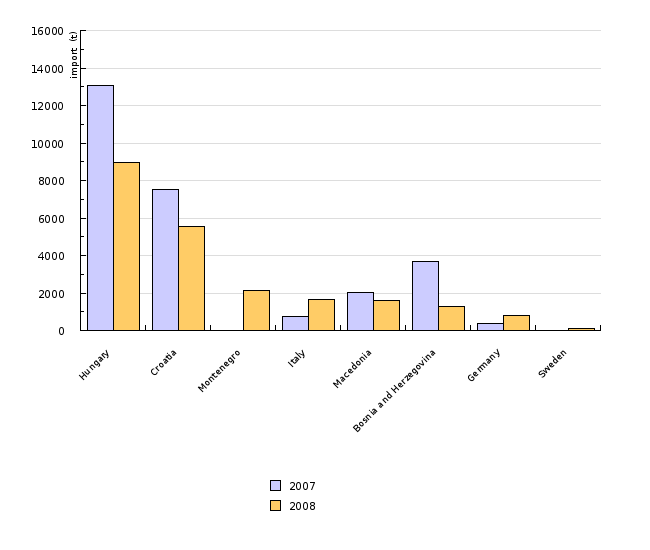[OD04] Transboundary shipments of waste

Key message

Import of waste to Slovenia has been rather stable in recent years, mainly provided for the needs of a recovery facility processing waste lead accumulators. In 2007, about 27 thousand tonnes of waste were imported. Export has been rapidly increasing in recent years, nearly fourfold since 2004. In 2007, about 70 thousand tonnes of waste were exported, mainly to Austria and Germany.
Definition
The indicator shows the annual quantity of waste exported from and imported to Slovenia, which may be either hazardous or non-hazardous and for which approval must be obtained.
Transboundary shipping of waste is governed by the Basle Convention on the Control of Transboundary Movements of Hazardous Wastes and their Disposal (Official Gazette of the Republic of Slovenia - International Agreements, No. 15/93, 2/00 and 23/04), and Regulation (EC) No. 1013/06 on shipments of waste (OJ L, No. 190/06). The Regulation is implementing the Basle Convention, the OECD Council Decision on the control of transboundary movements of wastes, and the results of the Lomé Conference.
Import of waste to Slovenia for the purpose of depositing into or onto land is prohibited. It is only allowed if such waste will be safely disposed of in some other manner or recovered, and if sufficient technical capacities are available.
Export of waste from Slovenia for disposal purposes is only allowed, if sufficient technical capacities and facilities required for harmless disposal are not available in the territory of the Republic of Slovenia or if such export is not in conflict with the provisions of Regulation (EC) No. 1013/06.
Charts
Transboundary Shipment of Waste Database, Environmental Agency of the Republic of Slovenia, 2008
| 1995 | 1996 | 1997 | 1998 | 1999 | 2000 | 2001 | 2002 | 2003 | 2004 | ||
|---|---|---|---|---|---|---|---|---|---|---|---|
| import | 1000 t | 22.1 | 21.4 | 19.5 | 13.4 | 18.4 | 22.3 | 20.5 | 20.9 | 23.2 | 25.6 |
| export | 1000 t | 1.6 | 5.5 | 2.1 | 3.2 | 3 | 4.7 | 7.9 | 10.7 | 14.7 | 18.4 |
| 2005 | 2006 | 2007 | 2008 | ||||||||
| import | 1000 t | 23.1 | 22.9 | 27.4 | 22.1 | ||||||
| export | 1000 t | 24.9 | 39.8 | 69.7 | 102.7 |
Zbirka Čezmejno pošiljanje odpadkov, Agencija Republike Slovenije za okolje, 2010
| Austria | Germany | Hungary | Croatia | Bosnia and Herzegovina | Serbia | Poland | France | Romania | ||
|---|---|---|---|---|---|---|---|---|---|---|
| 2007 | t | 29325.7 | 26194.7 | 13299.2 | 763.1 | 80.4 | 25 | |||
| 2007 | % | 42.1 | 37.6 | 19.1 | 1.1 | 0.1 | 0 | |||
| 2008 | t | 35323.1 | 24089.1 | 18946.1 | 16715.7 | 3390.4 | 2815.7 | 1269.3 | 73.6 | |
| 2008 | % | 34.4 | 23.5 | 18.5 | 16.3 | 3.3 | 2.7 | 1.2 | 0.1 |
Zbirka Čezmejno pošiljanje odpadkov, Agencija Republike Slovenije za okolje, 2010
| Hungary | Croatia | Montenegro | Italy | Macedonia | Bosnia and Herzegovina | Germany | Sweden | ||
|---|---|---|---|---|---|---|---|---|---|
| 2007 | t | 13072.6 | 7531 | 0 | 738.7 | 2018.9 | 3656.8 | 373.4 | 0 |
| 2007 | % | 47.7 | 27.5 | 0 | 2.7 | 7.4 | 13.4 | 1.4 | 0 |
| 2008 | t | 8967.9 | 5562.5 | 2155.1 | 1673.8 | 1591.8 | 1280.2 | 811.8 | 91.5 |
| 2008 | % | 40.5 | 25.1 | 9.7 | 7.6 | 7.2 | 5.8 | 3.7 | 0.4 |
Zbirka Čezmejno pošiljanje odpadkov, Agencija Republike Slovenije za okolje, 2010
| 2007 | 2008 | ||
|---|---|---|---|
| IMPORT - recovery | t | 27391.3 | 22134.6 |
| IMPORT - recovery | % | 100 | 100 |
| IMPORT - disposal | t | 0 | 0 |
| IMPORT - disposal | % | 0 | 0 |
| EXPORT - recovery | t | 54164.7 | 72843.9 |
| EXPORT - recovery | % | 77.7 | 71 |
| EXPORT - disposal | t | 15523.5 | 29779.1 |
| EXPORT - disposal | % | 22.3 | 29 |
Goals
To ensure own recovery capacities and capacities for disposal – the principle of self-sufficiency; to properly monitor the shipping of waste, including the certificate on final recovery or disposal of waste; and particularly to ensure a high level of environment protection and protection of human health (to limit the transboundary shipments of waste to the minimal level that still enables environmentally sound waste management); to ensure that waste is recovered and disposed of as close as possible to their place of origin; to limit the generation of hazardous waste (in terms of quantity as well as the level of hazardousness); the state must ensure self-sufficiency in waste management, recovery and disposal of waste as close as possible to their place of origin, with recovery prevailing over disposal. The State is further obliged to provide for environmentally safe waste management and to prevent illegal shipments of waste.
To ensure final disposal and recovery of hazardous waste, and to use the infrastructure within the EU when national facilities are not sufficient or non-existent.
Comment
In recent years, the quantities of imported waste have slightly fluctuated between 20,000 and 27,000 tonnes per year. Since the majority of imported waste is processed by one recoverer, the quantity of imported waste depends on the quantity of waste collected within Slovenia. In 2007 waste lead accumulators, their parts and lead ash for recovery in MPI-Reciklaža d. o. o. were imported from Hungary, Croatia, and Bosnia and Herzegovina, and party also from Macedonia, Germany and Italy. In the past years, several acidic and alkaline solutions were imported in order to be recovered in Cinkarna Celje.
In 2007 Slovenia mainly exported sludge from urban waste water treatment plants (31%) and mixed waste in which at least one type of waste was designated as hazardous (24%). Exports also consisted of solid waste from waste gas treatment (9%), washing liquids and mother liquors (6 %), biodegradable kitchen waste (6%) and other waste. They were disposed of or recovered in Austria (42%), Germany (37%) and Hungary (19%), and some in Poland, France and Romania.
Export of waste has been increasing in recent years. In 2007, it was more than doubled compared to the previous year. Such increase is the result of larger volume of sludge from urban wastewater treatment plants and of mixed waste in which at least one type of waste was designated as hazardous. The latter was not exported in previous years. In 2005, the export of sludge from urban waste water treatment plants amounted to approximately 1,730 tonnes (7% of the total quantity), in 2006 to approximately 14,200 ton (36% of the total quantity), and in 2007 already to approximately 21,600 tonnes (31% of the total quantity).
According to a study carried out by the European Topic Centre on Waste and Material Flow, transboundary shipments of waste crossing the EU Member States borders has heavily increased in the last decade. This increase is a result of transporting hazardous and non-hazardous waste, as well as illegal shipments. In the period from 1997 to 2005, both legal export and import marked a nearly fourfold increase. 80 % of waste was exported for recovery. Transboundary shipments of hazardous and problematic waste is mainly resulting from price differences for recovery and disposal of waste, insufficient domestic capacities for recovery of waste and the need for special processing technologies. In general, bigger countries have more diverse and technologically sophisticated facilities for recovery and disposal of waste.
Also increasing are transboundary shipments waste paper, cardboard, plastics and metal. Partly due to higher legal requirements for the recovery of waste, and partly because of the Asian market which is competitive primarily because of low shipment costs. The ships bringing goods from these countries offer very attractive prices on their way back.
Methodology
The objectives have been taken from the Operational Programme on waste deposition aiming at the reduction of deposited quantities of biodegradable waste (Novelation of March 2008, pages 39 and 40), the National Environmental Action Plan 2005-2012 (Chapter 4.4.1) and the Basel Convention.
The data have been collected on the basis of the legislation in force, i.e. the Basle Convention on the Control of Transboundary Movements of Hazardous Wastes and their Disposal (Official Gazette of the Republic of Slovenia – International Agreements, Nos. 15/93, 2/00 and 23/04) and the EU legislation. EU Legislation was modified in 2006.
Regulation (EC) No. 259/93 was replaced by Regulation (EC) No. 1013/06 which became effective in mid 2007. Also implemented was Commission Regulation (EC) No. 1418/07 concerning the export for recovery of certain waste listed in Annex III or IIIA to Regulation (EC) No. 1013/06 of the European Parliament and of the Council to certain countries to which the OECD Decision on the control of transboundary movements of wastes does not apply.
Wastes which require approval for import or export are, according to the Act Ratifying the Basle Convention on the Control of Transboundary Movements of Hazardous Wastes and their Disposal (Official Gazette of the Republic of Slovenia – International Agreements, Nos. 15/93, 2/00 and 23/04) – defined as wastes that belong to any category contained in Annex I to the Basle Convention, unless they do not have any of the characteristics contained in Annex III to the Basle Convention (show no hazardous properties), and – wastes that are not covered under the first paragraph (show no hazardous properties), but are defined as, or are considered to be, hazardous waste by the domestic legislation of the country of export, import or transit. This means that, considering the provisions of the Basle Convention and of Regulation (EC) 1013/2006, these can also be wastes which do not show any hazardous properties, but approval is required for their transboundary movement, for example if a country desires stricter control over deliveries of paper, glass, tyres or similar.
Any waste treatment facility in the country of importation that recovers or disposes of wastes for which it has obtained all the necessary approvals for import, transit or export of waste is obliged to present to the Environmental Agency of the Republic of Slovenia, to the competent body in the country of importation and in the country of transit, and to the supplier of wastes, a certificate of their disposal or recovery no later than within one year from the receipt of the shipment if the waste is subject to final procedures, or within two years from the receipt of shipment if the waste is subject to intermediary procedures of disposal/recovery. The form to be completed shows the date of shipment, delivery and receipt of waste by the provider of disposal or recovery, and the date of actual disposal/recovery of such waste, as well as the quantities of transported, delivered, received and disposed/recovered waste.
The data from transportation papers on the executed disposal/recovery of waste are entered into the database of transboundary shipments of wastes in which all issued approvals are also recorded. These data then constitute the basis for records on actually imported and exported quantities of waste under each issued approval, and for reporting to the Secretariat of the Basle Convention in accordance with its Articles 13 and 16, and to the European Commission in accordance with Article 51 of Regulation (EC) No. 1013/2006. Data on permitted transboundary shipments of waste acquired by such procedure is reliable and accurate.
Other sources and literature:
- EARS, 2008. Reports under the Basle Convention.
- MESP, 2008. Operational Programme on Waste Deposition.
- EEA (ETC/RWM), 2008. Transboundary shipments of waste in the EU (Developments 1995 – 2005 and possible drivers; Technical report 2008/1).
- IMPEL-TFS, 2006. IMPEL-TFS verification - 2 Project report: Is what you see, what you get?












